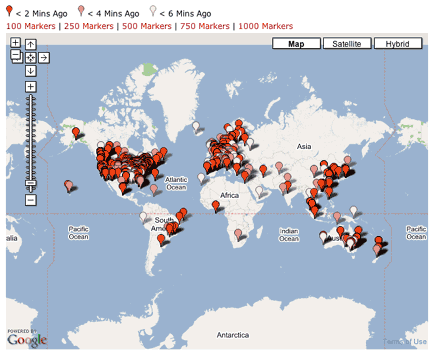A few weeks back, Microsoft’s Robert Scoble invited me to join Bill Gates, Kelly Goto, Roger Black, Lynda Weinman and other luminaries at Mix 06, a Microsoft-hosted “72-hour conversation” that wraps today in Las Vegas. Purpose of event: to “mix the next web now.”
It was like receiving an invitation from the emperor.
You may think “Web 2.0” and the “next web” are meaningful, industry-shaping concepts, or you may view them as marketing spin. You may trust that Microsoft wishes to be a citizen of the emerging state or suspect that it wants to be king. Whatever you hope or fear, and whatever value you place on such gabfests, to participate would surely be to learn. Plus you’d get to rub elbows with pirates and pundits from Tim O’Reilly and Marc Canter to Molly Holzschlag and some of the big brains behind eBay and Amazon.
Yet after at least two minutes of agonizing inner debate, I declined Microsoft’s invitation. Timing, which is also the secret of comedy, was the problem. Mix 06 followed SXSW too closely. As a business owner, I could afford to stay away from my agency for one week, but not for two.
Although a lot of designers, writers, and technologists seem to have been able to hopscotch from Austin to Vegas without so much as checking their office mailbox, I couldn’t.
Here in New York City there were jobs to finish and meetings to attend. There were clients to see and accountants and attorneys to see and pay. In Las Vegas they might be polishing up HTML 6 or figuring out how to make readers write all the content and pay for it, but back in my studio I had voice mails and RFPs and PDFs and Photoshop comps to sort through. (Just like you!)
Eric Meyer, one of the smartest people I have ever known, is at Mix 06 and has recorded some impressions, the most designer-relevant of which concern how much more CSS work Microsoft plans to do on IE7. (Answer: none.)
There is also a photo of Eric Meyer excessively enjoying free Internet Explorer stickers and bottled water.
Simon St Laurent, another of the smartest people I have ever known, has written a next web column on why the XML web, semantic web, and services web haven’t happened yet (and may never) while AJAX/”Web 2.0″ has, kind-of. Reading Simon’s column might almost be as good as attending Mix 06.
And Tim O’Reilly has blogged what he was planning to talk about while sharing a stage with Bill Gates. (And if I were sharing a stage with Bill Gates you can bet I’d blog it, too. After all, here I am doing nothing and getting a nice post out of it.)
There’s also a post and video of the actual conversation between Bill Gates and Tim O’Reilly, although, oddly, the video is not in QuickTime format.
Tim O’Reilly starts the conversation by telling Bill Gates how a Tim O’Reilly blog post launched Web 2.0 and led thousands of people to buy and sell stuff. That is as far as I got watching the video.
I guess if you are talking to Bill Gates you have to tell him who you are, even if you are Tim O’Reilly.
Well, anyway, I didn’t go to Mix 06, so I have lost untold thousands of pundit karma points. But this morning I read Hippos Go Berserk! to my kid. And even though we have read that book together at least 562 times, she found it fresh and exciting and new. And so did I.
Good stories stay new.
Fascinating and industry-changing revelations are likely emerging from Mix 06. I’m a bit sorry to miss the first utterances of them. But however brilliant such revelations may be, and however far their ripples spread, my web will not change. Whatever the pundits and pirates may say this week, my web is about content.
No matter what’s said at any conference, my web will continue to be about good writing and good design. Because that’s what I care about. And your web is your web because you care about what you care about. And whatever that is, there’s plenty of it to be found or made on this big web we share.
No matter how many new marketing phrases and acronyms emerge (some even with concepts attached), and no matter how much money some people make or lose betting on them (and the choice of Las Vegas as venue is telling), what I value does not change.
And that’s what I learned at Mix 06.

